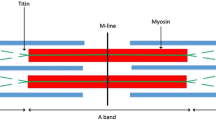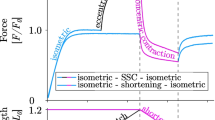Summary
-
1.
The generation of long term facilitation (LTF), a form of synaptic facilitation in Crustacea that results from maintained synaptic activity, is established for the first time in an intact animal. Facilitation of stretcher muscle myogram amplitude could be monitored in crayfish (Procambarus clarkii) while stimulating the excitor motoneuron in both intact animals and isolated preparations (Figs. 2, 3).
-
2.
At an average stimulation frequency of 8 Hz, colder temperatures enhance the development of LTF, monitored either intracellularly or by myogram (Figs. 1, 2). Neuromuscular depression counteracts the effects of LTF on myogram amplitude at extremely cold temperatures (5 °C, Fig. 4), or after extended stimulation periods at less cold temperatures (10 °C). Less LTF and negligible depression are detected during stimulation at warmer temperatures (15 °–20 °C).
-
3.
LTF is produced most effectively at and below the acclimation temperature. The temperature range favouring effective LTF development shifts with a decrease in acclimation temperature. Animals acclimated at a low temperature (7 °C) and tested at 15 °C show less rapid onset of LTF than animals acclimated at 17 °C. In addition, cold-acclimated animals show reduced ability to generate LTF at warmer temperatures and delayed onset of neuromuscular depression at cold temperatures.
-
4.
Orconectes virilis, a northern crayfish, studied in vitro, accomplishes nearly complete compensation of LTF development during cold acclimation (Fig. 6). At warm test temperatures, cold-acclimated animals show much reduced LTF.
-
5.
Procambarus, a crayfish from temperate regions, exhibits partial compensation of LTF development during cold acclimation when tested in vitro (Fig. 5). There is little reduction of LTF at warmer temperatures after cold acclimation. Temperature compensation is more complete in intactProcambarus than in the isolated claw (Fig. 4).
-
6.
It is concluded that LTF can serve as a mechanism to enhance neuromuscular performance at low temperatures, and that the temperature range over which LTF appears can be modified by thermal acclimation.
Similar content being viewed by others
Abbreviations
- LTF :
-
long term facilitation
- e.j.p. :
-
excitatory junction potential
References
Aiken DE (1969) Ovarian maturation and egg laying in the crayfishOrconectes virilis: Influence of temperature and photoperiod. Can J Zool 47:931–935
Atwood HL (1973) Crustacean motor units. In: Stein RB, Pearson KB, Smith RS, Redfords JB (eds) Control of posture and locomotion. Plenum, New York, pp 87–104
Atwood HL, Swenarchuk LE, Gruenwald CR (1975) Long term synaptic facilitation during sodium accumulation in nerve terminals. Brain Res 100:198–204
Bullock TH (1955) Compensations for temperature in the metabolism and activity in poikilotherms. Biol Rev 30:311–342
Charlton MP, Thompson CS, Atwood HL, Farnell B (1980) Synaptic transmission and intracellular sodium: Ionophore induced sodium loading of nerve terminals. Neurosci Lett 16:193–196
Florey E, Hoyle G (1976) The effects of temperature on a nerve-muscle system of the Hawaiian ghost crabOcypode ceratophthalma (Pallas). J Comp Physiol 110:51–64
Gruenwald CR (1972) A study of the mechanism of long term facilitation in the blue crabCallinectes sapidus. M Sc Thesis, University of Toronto
Harri M, Florey E (1977) The effects of temperature on a neuromuscular system of the crayfishAstacus leptodactylus. J Comp Physiol 117:47–61
Harri M, Florey E (1979) The effects of acclimation temperature on a neuromuscular system of the crayfishAstacus leptodactylus. J Exp Biol 78:281–293
Hatt H, Smith DO (1976) Synaptic depression related to presynaptic axon conduction block. J Physiol (Lond) 259:367–393
Hubbard JI, Jones SF, Landau EM (1971) The effect of temperature change upon transmitter release, facilitation and post-tetanic potentiation. J Physiol (Lond) 216:591–609
Jacobs JR (1980) Studies on the physiological and behavioural relevance of long term facilitation. M Sc Thesis, University of Toronto
Sherman RG, Atwood HL (1971) Synaptic facilitation: Long term neuromuscular facilitation in crustaceans. Science 171:1248–1250
Silverthorn SU (1975) Hormonal involvement in thermal acclimation in the fiddler crabUca pugilator (Bosc). II: Effects of extracts on tissue respiration. Comp Biochem Physiol 50A:285–290
Smith DO (1980) Mechanisms of action potential propagation failure at sites of axon branching in the crayfish. J Physiol (Lond) 301:243–259
Swenarchuk L (1975) Long term facilitation at a crayfish neuromuscular synapse. PhD Thesis, University of Toronto
Author information
Authors and Affiliations
Additional information
The authors wish to thank Johnathan Schmidt for assisting with the figures. This work was supported by a N.S.E.R.C. grant to H.L.A. and financial assistance to J.R.J. by an Aquitaine Centennial Scholarship.
Rights and permissions
About this article
Cite this article
Jacobs, J.R., Atwood, H.L. Effects of thermal history on long term neuromuscular facilitation in intact crayfish and isolated claw preparations. J. Comp. Physiol. 143, 53–60 (1981). https://doi.org/10.1007/BF00606068
Accepted:
Issue Date:
DOI: https://doi.org/10.1007/BF00606068




